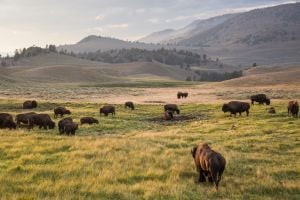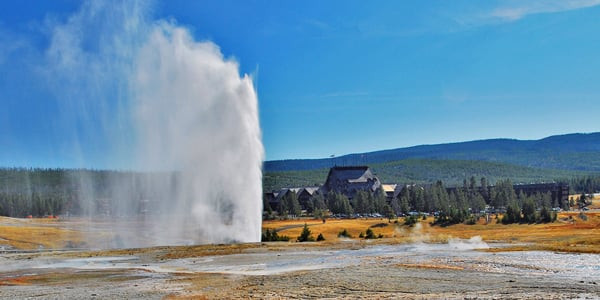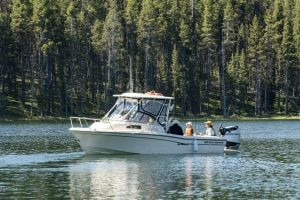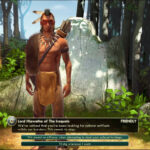Are you planning a trip to the majestic Yellowstone National Park and wondering how to make the most of your journey? At SIXT.VN, we understand the importance of seamless travel experiences, especially when exploring natural wonders like Yellowstone. We’re here to provide expert guidance, covering everything from planning your trip to ensuring a smooth and enjoyable visit. Whether you are thinking about the best time to visit Yellowstone, or require airport transfer services, SIXT.VN can help you arrange it.
1. Understanding Yellowstone National Park
Yellowstone National Park, established in 1872, is a natural gem spanning over 2.2 million acres, primarily in Wyoming but extending into Montana and Idaho. Known for its diverse wildlife, geothermal features, and dramatic landscapes, Yellowstone attracts millions of visitors annually, eager to witness its unique beauty and natural phenomena.
1.1. Why Visit Yellowstone?
Yellowstone offers a plethora of attractions and activities that cater to diverse interests:
- Geothermal Wonders: Explore iconic geysers like Old Faithful, vibrant hot springs, and bubbling mud pots.
- Wildlife Encounters: Observe bison, elk, wolves, bears, and numerous bird species in their natural habitats.
- Scenic Landscapes: Discover vast valleys, dense forests, pristine lakes, and cascading waterfalls.
- Outdoor Activities: Engage in hiking, fishing, camping, boating, and wildlife watching.
1.2. Best Time to Visit Yellowstone
According to the National Park Service, the peak season is during the summer months (June to August) because all park roads are open, offering full access to attractions and activities. However, this is also the busiest time, with larger crowds and higher prices.
Spring (April-May) and Fall (September-October) offer a balance with fewer crowds and pleasant weather. Some roads may be closed due to snow, but many areas remain accessible. Wildlife viewing is particularly rewarding during these seasons.
Winter (November-March) transforms Yellowstone into a snowy wonderland, ideal for cross-country skiing, snowshoeing, and snowmobiling. Some roads are closed to regular vehicles, but guided snowmobile and snowcoach tours provide access to the park’s interior.
2. Planning Your Trip to Yellowstone
Effective planning is essential to ensure a smooth and memorable trip. Consider the following steps:
2.1. Determine Your Travel Dates
Select your travel dates based on your preferred activities and weather conditions. Summer is perfect for hiking and boating, while winter is ideal for snow-based adventures. Spring and fall offer a mix of both.
2.2. Choose Your Entry Point
Yellowstone has five entrance stations, each offering access to different parts of the park:
- North Entrance (Gardiner, Montana): Open year-round, providing access to Mammoth Hot Springs and the northern range.
- Northeast Entrance (Cooke City, Montana): Open year-round, offering access to the Lamar Valley and wildlife watching opportunities.
- West Entrance (West Yellowstone, Montana): The most popular entrance, providing access to geyser basins and the Old Faithful area.
- South Entrance (Jackson, Wyoming): Provides access to Yellowstone Lake and the Grand Teton National Park.
- East Entrance (Cody, Wyoming): Offers access to the Yellowstone River and the Grand Canyon of the Yellowstone.
2.3. Transportation Options
Choosing the right mode of transportation is crucial for exploring Yellowstone.
- Car: Renting a car offers flexibility and allows you to explore the park at your own pace. SIXT.VN provides a wide range of rental options to suit your needs.
- Motorcycle: Experience the open road and scenic beauty on a motorcycle. Be prepared for varying weather conditions and limited storage space.
- RV/Campervan: Ideal for those who prefer to camp within the park. Reservations are essential, and size restrictions may apply.
- Shuttle/Tour Bus: Opt for guided tours and shuttle services if you prefer not to drive. These offer convenience and expert insights.
2.4. Accommodation Options
Yellowstone offers a variety of lodging options both inside and outside the park:
- In-Park Lodges and Hotels: Choose from historic hotels like the Old Faithful Inn or modern lodges like the Grant Village Lodge. Book well in advance, as these fill up quickly.
- Campgrounds: Several campgrounds are available within the park, offering a range of amenities. Reservations are highly recommended.
- Nearby Towns: Stay in gateway towns like West Yellowstone, Gardiner, or Cody, which offer hotels, motels, and vacation rentals.
- Vacation Rentals: Sites like Airbnb and VRBO offer a variety of rental houses, cabins, and apartments near Yellowstone’s entrances, perfect for families or groups looking for a home-away-from-home experience.
2.5. Obtain Necessary Permits and Reservations
Ensure you have the necessary permits and reservations before your trip:
- Park Entrance Pass: Purchase a Yellowstone National Park pass online or at the entrance station.
- Camping Reservations: Reserve your campsite well in advance through the National Park Service website.
- Tour Reservations: Book guided tours and activities ahead of time, especially during peak season.
2.6. Create a Detailed Itinerary
Plan your daily activities and prioritize the attractions you want to see. Consider the driving distances between different areas and allocate sufficient time for each destination.
3. Essential Travel Tips for Yellowstone
To maximize your experience and ensure safety, keep these travel tips in mind:
3.1. Pack Appropriately
Yellowstone’s weather can be unpredictable, so pack layers of clothing, including waterproof and windproof outerwear. Comfortable hiking shoes, sunscreen, insect repellent, and a hat are also essential.
3.2. Stay Hydrated and Carry Snacks
Bring plenty of water and snacks, especially if you plan to hike or spend long hours exploring. Food options within the park can be limited and expensive.
3.3. Be Aware of Wildlife Safety
Maintain a safe distance from wildlife, and never approach or feed animals. Carry bear spray when hiking in bear country and know how to use it. According to the National Park Service, bear spray is highly effective in deterring bear attacks when used correctly.
3.4. Follow Park Regulations
Adhere to park regulations and guidelines to protect the environment and ensure your safety. Stay on designated trails, avoid disturbing wildlife, and dispose of waste properly.
3.5. Prepare for Altitude
Yellowstone sits at a high elevation, so take it easy on your first day and allow your body to acclimatize. Drink plenty of water and avoid strenuous activities.
 Lamar Valley Yellowstone National Park
Lamar Valley Yellowstone National Park
3.6. Stay Connected
Cell phone service can be unreliable in some areas of Yellowstone. Consider purchasing a satellite phone or renting a portable Wi-Fi device to stay connected.
3.7. Check Road Conditions
Road closures and construction are common in Yellowstone, especially during spring and fall. Check the park’s website or visitor centers for the latest road conditions before you travel.
3.8. Practice Leave No Trace Principles
Help preserve Yellowstone’s natural beauty by practicing Leave No Trace principles. Pack out everything you pack in, minimize campfire impacts, and respect wildlife.
4. Getting To Yellowstone National Park: A Detailed Guide
Planning your journey to Yellowstone National Park involves careful consideration of transportation options, entry points, and nearby airports. Whether you’re flying in, driving, or opting for a scenic road trip, here’s a comprehensive guide to help you navigate your way to this natural wonderland.
4.1. By Air: Nearest Airports
Flying into a nearby airport is a convenient option for many travelers. Here are the closest airports to Yellowstone National Park:
- Yellowstone Airport (WYS): Located in West Yellowstone, Montana, this is the closest airport to the park. It offers seasonal flights, primarily during the summer months, connecting to Salt Lake City (SLC).
- Bozeman Yellowstone International Airport (BZN): Situated in Bozeman, Montana, about 80 miles north of the park’s North Entrance, BZN offers a wider range of flights from major US cities year-round.
- Billings Logan International Airport (BIL): Located in Billings, Montana, approximately 230 miles northeast of Yellowstone, BIL provides numerous daily flights and is a good option if you plan to explore the park from the northeast.
- Jackson Hole Airport (JAC): Located in Jackson, Wyoming, about 50 miles south of the park’s South Entrance, JAC offers flights from several major cities and is ideal for visiting Grand Teton National Park in conjunction with Yellowstone.
- Idaho Falls Regional Airport (IDA): Situated in Idaho Falls, Idaho, around 180 miles west of the park, IDA offers regional flights and is a viable option if you plan to enter Yellowstone from the west.
SIXT.VN Tip: Consider booking flights to airports with more frequent and affordable options. From there, you can rent a car or use shuttle services to reach the park.
4.2. By Car: Driving Routes and Distances
Driving to Yellowstone National Park offers the flexibility to explore at your own pace and enjoy the scenic landscapes along the way. Here are some common driving routes:
- From Salt Lake City, Utah: Take I-15 north to Idaho Falls, then US-20 east to West Yellowstone. The drive is approximately 320 miles and takes about 5-6 hours.
- From Denver, Colorado: Take I-25 north to Casper, Wyoming, then US-26/US-20 west to the East Entrance. This route is around 580 miles and takes about 9-10 hours.
- From Seattle, Washington: Take I-90 east to Billings, Montana, then I-90 east to Livingston and US-89 south to the North Entrance. The drive is roughly 800 miles and takes about 12-14 hours.
- From Rapid City, South Dakota: Take I-90 west to Billings, Montana, then I-90 west to Livingston and US-89 south to the North Entrance. This route is approximately 550 miles and takes about 9-10 hours.
SIXT.VN Tip: Plan your route in advance, considering the driving distances, road conditions, and potential stops along the way. Use navigation apps like Google Maps or Waze to stay updated on traffic and road closures.
4.3. Car Rental Options
Renting a car is a popular choice for exploring Yellowstone, providing the freedom to visit various attractions and scenic spots. SIXT.VN offers a variety of rental options to suit your needs:
- Compact Cars: Ideal for solo travelers or couples, offering fuel efficiency and easy maneuverability.
- SUVs: Perfect for families or groups, providing ample space, comfort, and all-wheel-drive capability for varied terrains.
- Trucks: Suited for adventurous travelers who plan to go off-road or need to carry heavy equipment.
- Vans: Best for large groups, offering plenty of seating and storage space.
SIXT.VN Tip: Book your rental car in advance, especially during peak season, to ensure availability and the best rates. Consider adding extras like GPS navigation, child seats, and additional driver coverage.
4.4. Shuttle and Bus Services
If you prefer not to drive, shuttle and bus services offer convenient transportation to and within Yellowstone National Park:
- Xanterra Parks & Resorts: Provides transportation services within the park, including airport shuttles, scenic tours, and transportation between lodges.
- Yellowstone National Park Lodges: Offers shuttle services from nearby airports like Bozeman and West Yellowstone to park lodges.
- Private Shuttle Companies: Numerous private companies offer shuttle services from surrounding towns and airports to Yellowstone.
SIXT.VN Tip: Research and book shuttle and bus services in advance, particularly during peak season, to secure your spot. Consider the schedules, costs, and drop-off/pick-up locations to align with your itinerary.
4.5. Scenic Train Routes
While there are no direct train routes to Yellowstone, you can take Amtrak to nearby cities and then rent a car or use shuttle services to reach the park:
- Amtrak Empire Builder: This route stops in Shelby and Havre, Montana, which are several hours’ drive from the North Entrance.
- Amtrak California Zephyr: This route stops in Salt Lake City, Utah, where you can rent a car and drive to West Yellowstone.
SIXT.VN Tip: Train travel can be a scenic and relaxing alternative to driving. Check Amtrak’s schedules and routes to plan your journey accordingly.
5. Top Attractions and Activities in Yellowstone
Yellowstone is packed with awe-inspiring attractions and activities. Here are some of the must-see destinations:
5.1. Old Faithful Geyser
Witness the regular eruptions of this iconic geyser, one of Yellowstone’s most famous landmarks. Check the eruption schedule at the Old Faithful Visitor Education Center.
5.2. Grand Prismatic Spring
Marvel at the vibrant colors of this massive hot spring, the largest in the United States. The best views are from the overlook on the Fairy Falls Trail.
 Grand Prismatic Spring Yellowstone
Grand Prismatic Spring Yellowstone
5.3. Yellowstone Lake
Explore the shores of North America’s largest high-elevation lake. Enjoy boating, fishing, or scenic cruises on its pristine waters.
5.4. Lamar Valley
Known as “America’s Serengeti,” Lamar Valley is the best place to spot wildlife in Yellowstone. Look for bison, elk, wolves, and pronghorn.
5.5. Grand Canyon of the Yellowstone
Hike along the rim of this dramatic canyon and admire the stunning waterfalls, including the Upper Falls and Lower Falls.
5.6. Mammoth Hot Springs
Discover the terraced formations created by hot springs at Mammoth Hot Springs. Walk along the boardwalks and enjoy the unique landscape.
5.7. Hayden Valley
Another prime wildlife viewing area, Hayden Valley is home to bison, elk, and grizzly bears. Drive along the road and keep an eye out for animals.
6. Unique Experiences in Yellowstone
For a more immersive and unforgettable experience, consider these unique activities:
6.1. Wildlife Watching Tours
Join a guided wildlife watching tour led by expert naturalists. Learn about Yellowstone’s diverse ecosystem and spot elusive animals like wolves and bears.
6.2. Horseback Riding
Explore the park on horseback with a guided trail ride. Several outfitters offer rides ranging from one hour to full-day excursions.
6.3. Fishing
Cast a line in Yellowstone’s rivers and lakes. Obtain a fishing permit and try your luck at catching trout, grayling, and whitefish.
6.4. Hiking
Lace up your boots and explore Yellowstone’s extensive trail system. Choose from easy boardwalks to challenging mountain climbs.
6.5. Photography Tours
Capture stunning images of Yellowstone’s landscapes and wildlife with a photography tour. Learn tips and techniques from professional photographers.
6.6. Geyser Gazing at Night
Experience the magic of Yellowstone’s geysers under the stars. Join a ranger-led night program or venture out on your own with a flashlight.
7. Dining Options in Yellowstone
Yellowstone offers a variety of dining options, ranging from casual cafes to upscale restaurants:
7.1. Old Faithful Inn Dining Room
Enjoy a meal in the historic Old Faithful Inn Dining Room, known for its rustic ambiance and regional cuisine.
7.2. Lake Yellowstone Hotel Dining Room
Dine in elegance at the Lake Yellowstone Hotel Dining Room, offering stunning lake views and fine dining.
7.3. Grant Village Dining Room
Savor delicious meals at the Grant Village Dining Room, known for its diverse menu and family-friendly atmosphere.
7.4. Canyon Lodge Eatery
Grab a quick bite at the Canyon Lodge Eatery, offering a variety of casual options like sandwiches, salads, and pizza.
7.5. Roosevelt Lodge Cookout
Experience a traditional Western cookout at the Roosevelt Lodge, featuring steak, beans, and cornbread served around a campfire.
8. Essential Gear for Yellowstone
To make the most of your Yellowstone adventure, be sure to pack these essential items:
8.1. Binoculars
Enhance your wildlife viewing experience with a good pair of binoculars. Look for models with high magnification and a wide field of view.
8.2. Camera
Capture stunning photos of Yellowstone’s landscapes and wildlife with a high-quality camera. Consider bringing extra batteries and memory cards.
8.3. Hiking Boots
Protect your feet and ankles with sturdy hiking boots. Choose models with good traction and ankle support.
8.4. Backpack
Carry your essentials in a comfortable backpack. Look for models with padded straps and multiple compartments.
8.5. Bear Spray
Protect yourself from bear encounters with bear spray. Learn how to use it properly and keep it readily accessible.
8.6. First-Aid Kit
Be prepared for minor injuries with a well-stocked first-aid kit. Include items like bandages, antiseptic wipes, pain relievers, and insect repellent.
9. Staying Safe in Yellowstone
Yellowstone is a wild and unpredictable place. Follow these safety guidelines to protect yourself and the environment:
9.1. Maintain a Safe Distance from Wildlife
Stay at least 100 yards away from bears and wolves, and 25 yards away from other animals. Never approach or feed wildlife.
9.2. Stay on Designated Trails
Protect yourself from hot springs and other hazards by staying on designated trails and boardwalks.
9.3. Be Aware of Thermal Areas
Hot springs and geysers can be extremely hot and dangerous. Never touch or step into thermal areas.
9.4. Store Food Properly
Prevent attracting bears by storing food in bear-resistant containers or suspending it from trees.
9.5. Be Prepared for Weather Changes
Yellowstone’s weather can change rapidly. Be prepared for rain, snow, and temperature fluctuations.
9.6. Inform Someone of Your Plans
Let someone know your hiking plans and expected return time. Carry a map and compass and know how to use them.
10. Booking Your Yellowstone Trip with SIXT.VN
SIXT.VN is your trusted partner for planning a seamless and memorable trip to Yellowstone National Park. We offer a range of services to simplify your travel arrangements:
10.1. Airport Transfers
Arrive in comfort and style with our reliable airport transfer services. We’ll pick you up from the airport and take you directly to your hotel or lodge.
10.2. Car Rentals
Explore Yellowstone at your own pace with our wide selection of rental cars. Choose from compact cars, SUVs, trucks, and vans to suit your needs.
10.3. Accommodation Assistance
Let us help you find the perfect accommodation for your Yellowstone trip. We partner with hotels, lodges, and vacation rentals to offer you the best options.
10.4. Tour Packages
Discover Yellowstone’s highlights with our expertly crafted tour packages. Choose from wildlife watching tours, scenic drives, and hiking adventures.
10.5. Travel Insurance
Protect your investment with our comprehensive travel insurance plans. We offer coverage for trip cancellations, medical emergencies, and lost luggage.
10.6. 24/7 Customer Support
Enjoy peace of mind with our 24/7 customer support. We’re here to assist you with any questions or concerns before, during, and after your trip.
Planning a trip to Yellowstone National Park can be an exciting but daunting task. With careful planning and preparation, you can ensure a safe, memorable, and enjoyable adventure. Whether you’re interested in wildlife viewing, hiking, photography, or simply soaking in the natural beauty, Yellowstone has something for everyone. Remember to book your flights, accommodations, and rental car in advance, and be prepared for varying weather conditions and potential wildlife encounters.
 Fishing Boat Yellowstone Lake
Fishing Boat Yellowstone Lake
SIXT.VN is here to assist you every step of the way. From airport transfers and car rentals to accommodation assistance and tour packages, we offer a range of services to simplify your Yellowstone travel arrangements. Contact us today to start planning your dream trip!
FAQ: How to Travel to Yellowstone
1. What is the best time of year to visit Yellowstone National Park?
The best time to visit Yellowstone is during the summer (June to August) for full access and pleasant weather. Spring (April-May) and Fall (September-October) offer fewer crowds, while winter (November-March) is ideal for snow activities.
2. Which is the closest airport to Yellowstone National Park?
Yellowstone Airport (WYS) in West Yellowstone, Montana, is the closest, but it has limited seasonal flights. Bozeman Yellowstone International Airport (BZN) is a larger airport with more options.
3. How can I get around Yellowstone National Park?
Renting a car is the most flexible option. Shuttle services and guided tours are also available within the park.
4. Where should I stay when visiting Yellowstone?
You can stay inside the park at lodges and campgrounds (book well in advance) or in nearby gateway towns like West Yellowstone, Gardiner, or Cody.
5. What should I pack for a trip to Yellowstone?
Pack layers of clothing, including waterproof outerwear, comfortable hiking shoes, sunscreen, insect repellent, a hat, binoculars, and a camera.
6. How can I stay safe while viewing wildlife in Yellowstone?
Maintain a safe distance (at least 100 yards from bears and wolves, 25 yards from other animals), never approach or feed wildlife, and carry bear spray when hiking.
7. Do I need to make reservations for activities in Yellowstone?
Yes, it’s highly recommended to book accommodations, campsites, and guided tours well in advance, especially during peak season.
8. Are there any dining options inside Yellowstone National Park?
Yes, Yellowstone offers a variety of dining options, from casual cafes to upscale restaurants, located in the park’s lodges and villages.
9. How can SIXT.VN help me plan my trip to Yellowstone?
SIXT.VN offers airport transfers, car rentals, accommodation assistance, tour packages, and 24/7 customer support to simplify your Yellowstone travel arrangements.
10. What should I do to protect the environment during my visit to Yellowstone?
Practice Leave No Trace principles: pack out everything you pack in, minimize campfire impacts, stay on designated trails, and respect wildlife.




